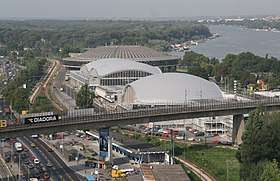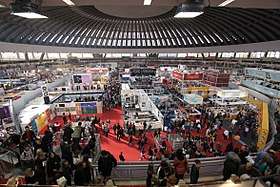Belgrade Fair
| Београдски Сајам | |
 | |
| Location | Savski Venac, Belgrade, Serbia |
|---|---|
| Coordinates | 44°47′46″N 20°26′8″E / 44.79611°N 20.43556°ECoordinates: 44°47′46″N 20°26′8″E / 44.79611°N 20.43556°E |
| Capacity | 100,000 m2 (1,100,000 sq ft), 14 halls |
| Construction | |
| Opened |
11 November 1937 August 1957 (new location) |
| Renovated | 1945 |
| Expanded | 1966–67, 1975 |
| Architect |
Branko Žeželj Milorad Pantović |
| Website | |
|
www | |
 |
| Location within neighborhood |
The Belgrade Fair or Beogradski Sajam (Serbian Cyrillic: Београдски Сајам) is a large complex of three large domes and a dozen of smaller halls which is the location of the major trade fairs of the capital city of Serbia. It is located in the municipality of Savski Venac, on the right bank of the Sava river. One of the most recognizable landmarks of Belgrade, it is colloquially referred to only as "Sajam".
Location
Sajam is located on the Sava's right bank, in the western foothills of the Topčidersko Brdo and the neighborhood of Senjak, built on it. The Topčiderka river flows into the Sava, in the Bay of Čukarica, just south of the fair complex, while Novi Beograd and the peninsula of Mala Ciganlija are just across the Sava, which is at this point the narrowest (200 m (660 ft)).[1]
History
Originally, complex was built as the modern neighborhood of Sajmište in Novi Beograd, across the Sava, and opened on 11 November 1937. As it was turned into the Sajmište concentration camp during the World War II, it was not reconstructed after 1945. City government selected three possible locations for the new fair and in 1953 the location of Šest Topola ("Six Poplars"), a former beach on the right Sava bank was chosen, in the westernmost extension of the neighborhood of Bara Venecija. Construction began in June 1955 and a new Sajam was finished in 1957. It was constructed by the architects Branko Žeželj and Milorad Pantović. Since then, Sajmište became known as Staro Sajmište ("old trade fair"). First exhibition premiered on 23 August 1957 and already from that year, Belgrade Fair is member of the UFI. The inaugural fair was the International Exhibition of Technics, with 1,500 exhibitors from 28 states. In 11 days it had 1,150,000 visitors, or 2 times more than Belgrade had inhabitants at the time.[2][3]
Second phase of the expansion of the complex began in 1966. Halls 7, 8 and 9 were built, but during the first exhibition held in them in the fall of 1966, they burned in fire. They were rebuilt in 1967, when the halls 10, 11 and 12 were also finished. The last phase was finished in 1975 when the western wing of the Hall 1, later renamed Hall 14 and today Hall 4, was finished.[3]
In 1961 the fair hosted two European sports championships: 1961 European Amateur Boxing Championships and, few months later, EuroBasket 1961. Both were held in the Hall 1. The same hall hosted the first major concert of the "youth culture and rock and roll" in Yugoslavia in 1966, with over 100 bands. Since then, the hall became a favorite venue for the "urban musical guerrilla", but also for the popular mainstream rock musicians. Concerts were held by Ekatarina Velika, Yu Grupa, Bajaga i Instruktori, Riblja Čorba. Foreign musicians include Eric Clapton (in 1984), Iron Maiden (1984, 2007), Deep Purple (2003, 2006), Alice Cooper, Kiss, Duran Duran, etc.[3] Occasionally, Serbian folk singers were also performing in the Hall 1, like Džej Ramadanovski (1992; 30,000 spectators).[4]
Transportation
Area in the vicinity of the Sajam is among the busiest transportation sections of Belgrade. Entire complex is surrounded by the railways and both railway bridges over the Sava which connect old and new sections of Belgrade, are crossing the river at Sajam: old bridge, right on the northern tip, and new bridge which rises above the Sajam itself. "Boulevard of Vojvoda Mišić" which runs next to the complex is a major route which connects outer neighborhoods like Banovo Brdo, Čukarica, Žarkovo, Košutnjak and Topčider, and thus one of the busiest single streets in Belgrade, well known for daily traffic jams. Just north of the Sajam is a highway and one of the largest interchanges in Belgrade, Mostarska Petlja, and a Gazela bridge over the Sava. Additionally, the tram lines are passing through the boulevard, too, and the very first tram line in Belgrade passed through this area (Gospodarska Mehana), connecting Kalemegdan and Senjak.
Characteristics
The Belgrade Fair is the largest institution of its kind in Serbia, covering an area of 24 hectares. All together, it has 14 halls which cover an exhibition area of 100,000 m2 (1,100,000 sq ft) square meters, dominated by the three large domes: Hall 1 (Largest hall with 109 m (358 ft) diameter dome with a combined area of 32,945 m2 (354,620 sq ft), or one third of the total area; it was the largest dome in the world 1957-1965 and largest Euoropean dome, Hall 2 and Hall 3. Belgrade Fair also has commercial space, depositories, and workhouses. Additional services include post office, bank, tourist agencies, carrier companies, custom, and ambulance. Also, within Fair there are several important hosting object of various purposes.
Every year Belgrade Fair hosts over 30 regular international fair manifestations. Over 5,000 companies exhibit on the Belgrade Fair annually, with more than 1.500,000 visitors Many of these manifestations are members of respectable international organizations: the International Fair of Technique and Technical Advancements, International Fair of Clothing - World Fashion, International Fair of Furniture, Equipment and Internal Decorations, and SEEBBE (Southeast Europe Building Belgrade Expo) are members of UFI, Paris. International fair "BG CAR SHOW – MOTOPASSION" is one of the eighteen registered centers for presentation of European automobile industry by OICA, Paris. In addition to regular manifestations, domes of Belgrade Fair host numerous other exhibitions, concerts, scientific and specialized meetings and the range of services of the Belgrade Fair is supported by bazaar of consumer goods. Since 2001, the Belgrade Fair is a member of CEFA (Central European Fair Association) and since September 2003, the International Fair of Tourism is a member of ETTFA.
City and Republic institutes for the cultural monuments protection are working jointly on a proposal to put Sajam under the state protection. In January 2009 the government declared it a cultural monument, but then revoked its own decision a week later.[5]
See also
References
- ↑ Beograd - plan i vodič. Geokarta. 1999. ISBN 86-459-0006-8.
- ↑ Ana Jovanović (8 June 2017), "Hale pune raznih inovacija", Politika (in Serbian), p. 18
- 1 2 3 Ana Jovanović (11 September 2017), "Mesto za trgovinu robom i izlaganje poslovnih ponuda", Politika (in Serbian), p. 15
- ↑ Ko je ko u Srbiji 1996, page 473. Bibliofon. 1996.
- ↑ D.Mučibabić & S.Despotović (27 January 2009), "Beogradski sajam – između kulturnog spomenika i poslovnog centra", Politika (in Serbian)
External links
| Wikimedia Commons has media related to Belgrade Fair. |
| Preceded by İnönü Stadium Istanbul |
EuroBasket Final Venue 1961 |
Succeeded by Centennial Hall Wrocław |
